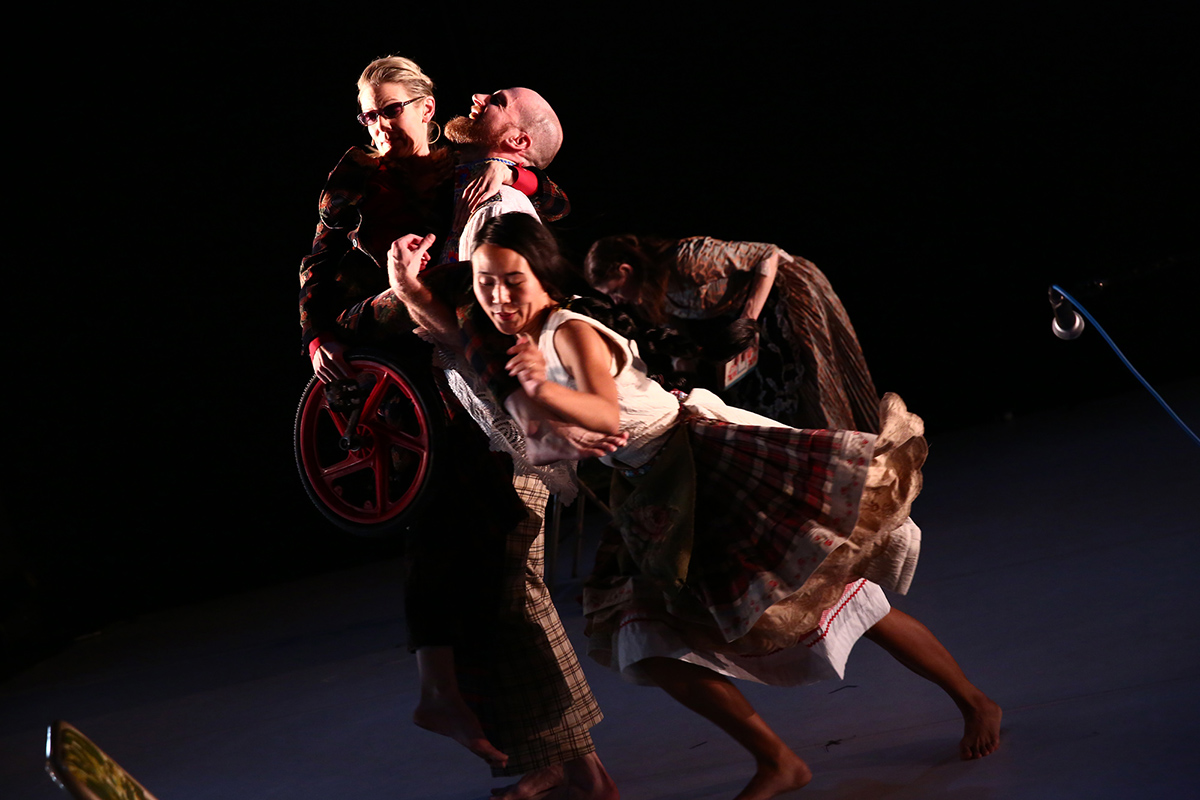Q&A: Big Dance Theater’s Annie-B Parson

Annie-B Parson. / Photo by Ike Edeani
To say that Big Dance Theater has made some big moves in the past 25 years would be an understatement. Led by co-artistic directors, co-founders, and married couple Annie-B Parson and Paul Lazar, Big Dance Theater has received accolades for its synthesis of theater, literature, and dance. Take, for example, Supernatural Wife, which reimagined Euripides’ Alkestis with contemporary dance and video, or Man In A Case, a multimedia interpretation of two short stories by Anton Chekhov.
The New York-based company brought their adaptation of Chekhov to the Cutler Majestic in 2014—their most recent production in Boston. Big Dance Theater returns on Friday, this time to the Institute of Contemporary Art with Short Form, a five-part show commemorating their 25th anniversary. Short Form is inspired by folk tales, novellas, drawings, and other, well, short forms of literature.
Aside from Big Dance Theater’s productions, Parson has choreographed for high-profile projects such as David Byrne’s Here Lies Love and David Bowie’s Lazarus. Here, she discusses her process, and her celebrity choreography.
How did Short Form come about?
I was really stimulated by all the short form literature that’s been coming out, like short stories that are three sentences, formulating ideas in texts and tweets, and how people of all strides—politicians for example—are using the short form to express really big ideas. I felt like it would be interesting to look at that. It’s five short pieces of varying lengths. … In the middle of the show, there’s a party onstage for the audience. I think of it as a party, but it’s a piece. I call it “Intermission.” It’s a piece that the audience performs. Their performance is that they come onstage and they eat, drink, play ping-pong and have a little party. I don’t think they know that they’re in a performance but they are.
I hear there might be hot dogs.
Yeah! There’s going to be hot dogs. Actually, they’re mini dogs. When I thought of doing these short pieces I was really concerned about having an intermission—I really am not a fan of intermissions. From a standpoint of somebody that’s making an evening of theatre, the intermission just kills it. You leave the space, the bubble is burst, and energy is diffused. So I thought, let’s keep everybody together but give them something that’s kinetic and nutritious—well, not nutritious, but some sustenance like beer and Coke, you know? Keep them in the room, but let them have a break. It’s like recess in school. People concentrate a lot more after the intermission.
I’ve never thought of intermission as recess.
Right? It’s like a little warm-up before the second act because the audience physically engages and talk to each other. I don’t know whether they talk about the work or not, but the performers are out there and they talk to the performers. Then when the show starts people go back to their seats [and] they’re different than when they first walked into the theatre.

Short Form. / Photo by Paula Court
You’ve worked with some iconic artists, such as David Bowie, David Byrne, and St. Vincent. I’m curious as to what that was like in comparison to pieces you create for Big Dance Theater.
When you work with the music of Bowie, Byrne—who I’ve worked with directly on many, many productions—and St. Vincent, you’re working with artists who defy categories. I have to say that it’s incredibly inspiring. David Byrne and David Bowie are two of my favorite dancers and two of my favorite choreographers. In fact, when David Byrne first asked me to make something for him, my response was, “You’re my favorite choreographer. You should just make your own!” I couldn’t imagine anybody doing it better than he did.
I didn’t work directly with Bowie. I worked with Ivo van Hove, who was the director [of Lazarus]. He’s also a master—maybe the greatest theatre director in the world. And so you’re working with these gigantic artistic talents who redefine theater or music or pop music, and they’re so rare, the way they think, but I felt very free.
Even though it’s their work and not my self-expression or voice, so to speak, it’s not like they were trying to make me into somebody else. They were just in the back of my mind. When I’m making David Byrne’s work, I’m thinking of his body. Even if I bring in other dancers, I’m still thinking of his body, the way he moves, how he experiences the world, and what his music maps out for us. That would be true for St. Vincent. The way she moves, the way she experiences the world is very, very different. So yes, I’m in service to them, but I still am very, very free.
$15+, October 14 and 15, 8 p.m., Institute of Contemporary Art, 25 Harbor Shore Drive, icaboston.org.


